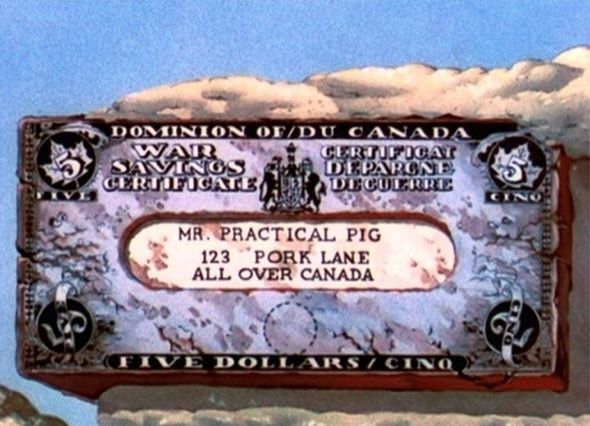
A still frame of a Canadian War Bond “brick” that Practical Pig uses to build his house in The Thrifty Pig, one of the four films commissioned by the National Film Board of Canada for the war effort.
World War II (WWII) started in September 1939 when Nazi Germany invaded Poland. The United States did not enter the war until December 7, 1941, when the Japanese bombed the Pearl Harbor Naval Base in Hawaii. The war was the largest armed conflict in world history and raged over six continents inflicting more than fifty million military and civilian deaths including six million Jews. It had a profound effect on the world order ushering in the nuclear era, the Cold War, and the creation of the United Nations. Before the U.S. involvement in WWII, the Disney Studios felt the immediate effects of the conflict by losing nearly a third of its film revenues from Europe as Nazi aggression spread. This put serious financial pressures on the studio and its founding partners Walt and Roy Disney.
The Disney Studios were still reaping the successes of their first animated feature film, Snow White and the Seven Dwarfs, and were in the midst of completing the second feature, Pinocchio, while also building a new studio complex in Burbank, California in 1939. The company had borrowed to expand before the war broke out in Europe and with the loss of revenues from each country invaded by the Nazis, the studio began to feel the effects of the war in the diminishing foreign box-office receipts.
Domestically, in 1939 the United States was still grappling with the residual effects of the Great Depression. President Franklin Roosevelt was preparing the nation for the inevitable involvement in the war. Roosevelt persuaded Congress to “repeal the arms embargo provisions of the neutrality law so that arms could be sold to France and Britain.” After the fall of France in June 1940, “he pushed for a major military buildup and began providing aid in the form of Lend-Lease to Britain, which now stood alone against the Axis powers.” The Lend-Lease Act allowed the United States to send much needed food and supplies to Great Britain by passing a “cash and carry” law that prevented the president from extending credit to countries that could not immediately pay for supplies. It also allowed the U.S. to bide it’s time before getting involved in the conflict. (U.S. Congressional Record)
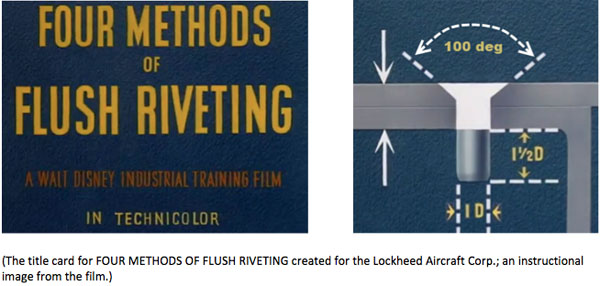
Meanwhile, by 1940, with financial pressures mounting at the studio, Walt was looking to for new business to replace what was lost in Europe. He approached the Lockheed Aircraft Corporation, which was just three and half miles from the Burbank studio lot, and convinced them to let him make an employee training film on aircraft riveting. He made Four Methods of Flush Riveting which demonstrated the countersink, the double-dimple, the pre-dimple, and the combination pre-dimple and countersinking methods of riveting for aircraft construction. This was created using the simplest animation techniques of sliding artwork on cels and animation camera dissolves with a very serious and dry voiceover. The film lacked any story and had no gags or humor, which can be found in some other educational and/or training films produced at Disney during this period. It was made with barebones economy but successfully displayed the unique advantages of using animation techniques that could not be achieved with live action photography. The animation medium allowed the viewer to see cross-sections and inner workings of anything, which was not possible with any other technique of the day.

Having completed Four Methods of Flush Riveting, Walt saw the potential for doing more such films outside of entertainment and invited several dozen businessman and representatives from defense industries, councils and commissions to the new Burbank studio on April 3, 1941, for a conference showcasing animation for education and training. In attendance was John Grierson, the British documentary filmmaker and commissioner of the National Film Board of Canada, which had been formed by the National Film Act of 1939. Walt screened for the group part of Fantasia, the yet to be released The Reluctant Dragon, early pencil test animation from The Wind in the Willows, and the Four Methods of Flush Riveting. Walt pitched the idea of Disney doing more educational and training films for cost.
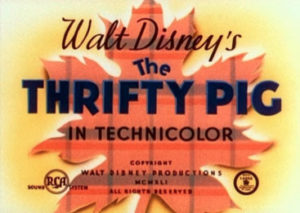
The title card for “The Thrifty Pig” uses a Canadian maple leaf as a design element under the text in all four of the films commissioned by the National Film Board of Canada.
The first of the four films produced was The Thrifty Pig, a four-minute PSA educating and encouraging the Canadian public to by war bonds. The primarily re-purposed existing animation from the Academy Award winning 1933 Silly Symphony Short The Three Little Pigs. The reuse of the animation with some minor augmentation and adjustments enabled Disney to create the film quickly and stay within the meager budget of $20,000.00 for all four war bond films ordered. That was $5,000.00 per short, a small amount considering eight years earlier in 1933 The Three Little Pigs short cost $22,000.00 to make at that time. So, reusing animation was a smart and viable way of creating this shorts for Canada and staying on budget and schedule.
The Thrifty Pig retells the Three Little Pigs story in a more succinct three-minute story line in which the Big Bad Wolf, this time in a Nazi swastika and uniform, huffs and puffs and blows down Fifer pig’s straw house. Fifer pig then escapes running to Fiddler pig’s house made of sticks, which the Big Bad Wolf also blows down. Both Fifer and Fiddler pig escape to Practical Pig’s house, which he has made strong out of war bond bricks. The house, complete with the Union Jack waving atop a flagpole in the front yard, has a solid foundation and Practical Pig was well prepared to ward off the aggressor. The Big Bad Wolf is unable to blow down the brick house and is chased off by Practical Pig throwing a hail of bricks at him. The character animation ends with the three pigs singing the classic tune ‘Who’s Afraid of the Big Bad Wolf?’ with the lyrics rewritten to; “Who’s afraid of the Big Bad Wolf? The Union Jack’s still waving; We’ll be safe from the Big Bad Wolf; If you lend your savings.” The moral being a home that is strong, prepared and in good order will be able to defend against the enemy and keep the wolf from your door.The remaining minute in the PSA is devoted to why the public should purchase war bonds. In a montage that begins with searchlights revealing “A Golden Opportunity” followed by “to do your part” in the spinning image of plane propeller, “to win this war” coming out of the midair collision of Nazi planes being shot down, the short conveys to the audience to “spend less” and “lend your savings” appearing in the smoke coming from factory chimneys. This is then followed by war savings bonds mimicking factory conveyor belts with the words, “BUY MORE AND MORE WAR SAVINGS CERTIFICATES” dissolving on and off before revealing ships, planes and tanks moving along the war bond conveyor belts. A war bond then flies into screen along with four coins as the words FIVE FOR FOUR appear. The bond and coins dissolve off as a searchlight sweeps the screen revealing fighter planes coming towards the screen firing their machine guns creating bullet holes that spell out “INVEST IN VICTORY,” which concludes the PSA.
The entire montage is visual with no voiceover only a music score and was similar for all four war bond shorts produced for Canada. Each short had a different montage that reused some animation but was mostly unique to each. The basic message was the same though, lend you savings by buying war bonds and keep your money fighting to win the war.
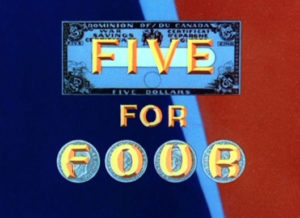
The Canadian War Savings Certificates campaign advocated buying five dollar bonds for only four dollars.
The voice talents for The Thrifty Pig included Billy Bletcher, best known as the voice of Peg Leg Pete, as the Big Bad Wolf; Pinto Colvig, who voiced Goofy and Pluto, as Practical Pig and Mary Moder as Fiddler Pig. Dorothy Compton voiced Fifer pig. As with the animation, the original recordings were likely used for as much as could be repurposed, including the singing. This would have further reduced costs.
The Thrifty Pig was released to movie theaters in Canada on November 19, 1941, just weeks before the bombing of Pearl Harbor. The second war bonds film, 7 Wise Dwarfs, was already in production.
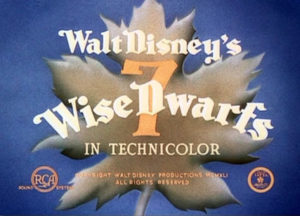 7 Wise Dwarfs also reused existing animation, this time from Snow White and the Seven Dwarfs. The short featured all of the Dwarfs and opens with a reuse of a little over a minute of original animation from the ‘Heigh Ho’ sequence. The Dwarfs are working in the mine singing, “We dig dig dig dig dig dig dig in our mine the whole day through; To dig dig dig dig dig dig dig is what we really like to do; It ain’t no trick to get rich quick; If you dig dig dig with a shovel or a pick; In a mine! In a mine! In a mine! In a mine! Where a million diamonds shine!” Much of this section is directly from the Snow White feature and was used exactly as is from the film with the exception of a few scenes being edited out. The repurposed film is used up until the point that the Dwarfs exit the mine, which clearly changes to new animation and singing of modified song lyrics, “Heigh-ho, Heigh-ho we’re the wisest dwarves we know (Whistle) Heigh-ho, Heigh-ho, Heigh-ho Heigh-ho, Heigh-ho It’s off to buy we go We’ll do our part with all our heart Heigh-ho, Heigh-ho, Heigh-ho Heigh-ho, Heigh-ho We all must help you know We’ll win the war with five for four Heigh-ho, Heigh-ho, Heigh-ho Heigh-ho, Heigh-ho we’ll help you find the gold We’ve done our part with all our heart Heigh-ho, Heigh-ho Heigh-ho, Heigh-ho, Heigh-Ho, Heigh-ho.”
7 Wise Dwarfs also reused existing animation, this time from Snow White and the Seven Dwarfs. The short featured all of the Dwarfs and opens with a reuse of a little over a minute of original animation from the ‘Heigh Ho’ sequence. The Dwarfs are working in the mine singing, “We dig dig dig dig dig dig dig in our mine the whole day through; To dig dig dig dig dig dig dig is what we really like to do; It ain’t no trick to get rich quick; If you dig dig dig with a shovel or a pick; In a mine! In a mine! In a mine! In a mine! Where a million diamonds shine!” Much of this section is directly from the Snow White feature and was used exactly as is from the film with the exception of a few scenes being edited out. The repurposed film is used up until the point that the Dwarfs exit the mine, which clearly changes to new animation and singing of modified song lyrics, “Heigh-ho, Heigh-ho we’re the wisest dwarves we know (Whistle) Heigh-ho, Heigh-ho, Heigh-ho Heigh-ho, Heigh-ho It’s off to buy we go We’ll do our part with all our heart Heigh-ho, Heigh-ho, Heigh-ho Heigh-ho, Heigh-ho We all must help you know We’ll win the war with five for four Heigh-ho, Heigh-ho, Heigh-ho Heigh-ho, Heigh-ho we’ll help you find the gold We’ve done our part with all our heart Heigh-ho, Heigh-ho Heigh-ho, Heigh-ho, Heigh-Ho, Heigh-ho.”
The signing voices do not match very well from the original feature film to this war bond short and the new animation lacks the production value afforded the original animation. Pinto Colvig, who did the voice of Grumpy and Sleepy in the Snow White and the Seven Dwarfs feature film, does the voice for Doc in the 7 Wise Dwarfs. It’s not a convincing match to Roy Atwell who voiced Doc in the feature. These war bond pictures were being done on very small budgets and at cost, that it is probable that Atwell wasn’t available or Colvig was on hand already for other projects and they just used him out of convenience. Considering the schedule and cost, compromises had to be made.
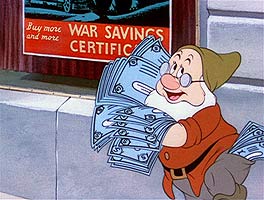 The new and the modified repurposed Dwarf animation in this short is flatter with the color palettes lacking the richness of the feature film. They had to forego the more complex color palettes used for modeling the characters that gave the Dwarfs more dimensionality in favor of a simpler, reduced number of colors. There was an attempt to mask this difference by not cutting directly from the original film animation to the new material. Instead, the short was designed so that it cuts from the interior animation of the dark mine to an exterior of the mine and the new animation—going from a lantern and jewel lit interior cavern to the exterior daytime. It works as best as it can and was all that they could do given the nature of the project—everyone had to make creative sacrifices.
The new and the modified repurposed Dwarf animation in this short is flatter with the color palettes lacking the richness of the feature film. They had to forego the more complex color palettes used for modeling the characters that gave the Dwarfs more dimensionality in favor of a simpler, reduced number of colors. There was an attempt to mask this difference by not cutting directly from the original film animation to the new material. Instead, the short was designed so that it cuts from the interior animation of the dark mine to an exterior of the mine and the new animation—going from a lantern and jewel lit interior cavern to the exterior daytime. It works as best as it can and was all that they could do given the nature of the project—everyone had to make creative sacrifices.
The 7 Wise Dwarfs ends in a similar fashion as The Thrifty Pig, with a montage of scenes and text extolling, “LEND YOUR SAVINGS… KEEP YOUR MONEY FIGHTING… BUY MORE AND MORE WAR SAVINGS CERTIFICATES.” The PSA ends with a war bond and four coins animating into frame and the text “FIVE FOR FOUR” dissolving on over them. That graphic holds for a beat before it dissolves off and a searchlight sweeps the frame as fighter planes, firing machineguns, strafe the screen creating bullet holes that spell out “INVEST IN VICTORY,” which concludes the film as the screen fades to black. This is reuse animation as are various scenes from the end montage from The Thrifty Pig. The filmmakers were clever in how they edited the final sequence of the films by reordering and mixing new and reused scenes in the montage of each of the four Canadian war bond films.
Just a week after the attack on Pearl Harbor and the United States entering WWII, The 7 Wise Dwarfs was released to Canadian theaters on December 12, 1941. Production was underway on the third film, Donald’s Decision, which also uses repurposed animation this time from Donald’s Better Self (1938).
Donald’s Decision showcases a much better integration of new animation with the repurposed animation liberally used for Donald’s Better Self, which is a perfect short to use. It depicts Donald conflicted between his good self, represented by a Donald angel, and his bad self, represented by a Donald devil character. Donald Duck works best when he has an antagonist to work against.
The short opens with a narrator saying, “Our fighting men must have your help they need more tanks,” as the titles dissolve to a radio, “more planes, more guns, more shells… never was the need more urgent, invest in war saving certificates today.” The scene cut to Donald Duck in a hammock, he reacts to the radio announcer saying, “… what would you be worth if the united nations lost this war…nothing…we must win! Enlist in our army of regular war savers today.” Donald, concerned, says he’s going to do it “tomorrow” as he rolls over and for a nap. His angel self comes out him, ghost like, and wakes Donald up telling him, not tomorrow, today.” The angel, voiced by Thelma Boardman, hands Donald his piggy bank and they proceed to walk on their way to the post office for war savings certificates. But as he passes a mailbox, the Devil character appears to convince Donald to spend the money on himself. There is a not-so-subtle visual of the red mailbox flag spins and reads a swastika as the Devil self emerges. Donald is voiced by Clarence “Ducky” Nash, the originator of Donald Duck’s voice.
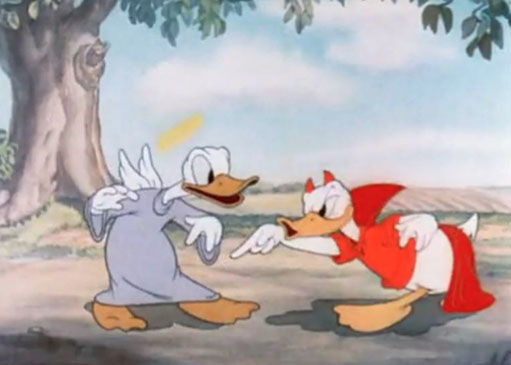
Donald’s Angel and Devil selves going at it to try and steer Donald’s decision; ©Disney
The Devil beats-up the angel self, throwing him into a pond. Angry, the angel flies up into the air, spinning fists like airplane propellers, and defeats the devil pummeling him into the ground, which then forms a grave topped with a flower. Much of this is reused animation from Donald’s Better Self. The angel then proceeds to lead Donald on his way. The animation is reused from Donald’s Better Self, but the backgrounds are new. In Donald’s Better Self the angel leads him to school, but in Donald’s Decision he is led to the Post Office to lend his savings in exchange for the war savings certificates. The reused animation and new backgrounds work seamless with the new portions created specific to this war savings certificate PSA, which was directed by Ford Beebe. Donald’s Decision was released on January 11, 1942, and has a running time of three minutes and thirty-five seconds.
The final war savings certificate PSA is All Together, which was directed by Jack King and featured Walt Disney reprising the voice of Mickey Mouse, Pinto Colvig as Doc, and Clarence “Ducky” Nash as Donald Duck. It was released on January 13, 1942, and featured reuse animation of Disney’s most notable characters, including the only animation appearance of Mickey Mouse.
The short opens with an establishing shot of Canadian Parliament Buildings with a parade moving in front. Cutting to a close-up of Pinocchio and Geppetto carrying a banner that reads ALL TOGETHER FOR WAR SAVINGS. As they exit screen left Cleo the Cat floats in on a balloon that has the word GET printed on it. Then the scene cuts to Donald Duck and his nephews Huey, Louie, and Dewey marching along in their scout uniforms each carrying signage that reads 5 FOR as the scene cut to a blue balloon that has a 4 on it attached to Pluto who is scratching himself. Pluto looks off screen, and then catches up to Donald and his nephews. The scene shows the signage bouncing along in frame as the blue balloon enters in screen right so that the message reads 5 FOR 4. The scene cut to Pluto marching along, bone in mouth, off screen left as a band wagon comes in with a banner reading HELP WIN THE WAR.
The scene cuts to a section of reused animation from The Band Concert (1935) with Mickey Mouse conducting to the patriotic music playing. The sync of the reuse animation to music is not perfect but it does work consider that The Band Concert uses The William Tell Overture, which is very different from the patriotic music. The reuse animation features Horace Horsecollar, Clarabelle Cow, and Goofy along with a few other lesser known characters.
From the scene of the band playing, the scene cuts to the Seven Dwarfs carrying signage that reads AL TOGETHER FOR WAR SAVINGS. Picking up the rear is Dopey, who trips and falls before getting back up and grabbing onto his sign post. The scene then spins into a round insignia on the wing of a war plane. The last minute of this three-minute PSA is a montage of war related images that drive home the message, ALL TOGETHER, YOU SERVE BY SAVING, ALL TOGETHER, YOU SAVE BY SERVING… KEEP YOUR MONEY FIGHTING UNTIL VICTORY IS WON… AL TOGETHER BUY WAR SAVINGS CERTIFICATES, BUY MORE AND MORE. The short ends with stylized light rays and sky, in the colors of the Union Jack, radiating out from behind a battleship as the short fades to black on a swell of music. The propaganda messages that ended each of the four war savings certificate films was designed to inspired audiences, a call to action, to act on supporting the war effort.
The music for all four of these Canadian war savings certificates films is less than optimally documented. The Thrifty Pig uses some of the music from Three Little Pigs, which is credited to Carl Stalling and Frank Churchill. But who did the arranging of that music and additional score material for The Thrifty Pig is unknown. On Donald’s Decision that reuses heavily from Donald’s Better Self, Oliver Wallace is credited with both. He did the original music Donald’s Better Self and modified it for Donald’s Decision. Considering that all four of these films were in production at the same time and released within a two-month window, it is my belief that Wallace worked on conforming and arranging the music for all of them. He was one of Disney’s premiere music directors at that time and was a highly experienced composer and was well versed in using public domain music.
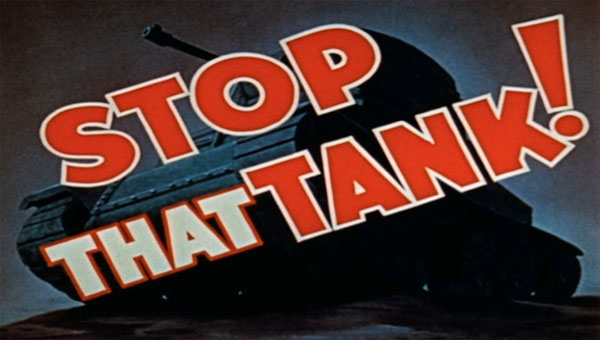
After completing the four war savings certificate film, a fifth film was commissioned by the National Film Board of Canada and The Department of National Defence [sic] and it was a training film, Stop That Tank, for the Boys Anti-Tank Rifle. The first three-minute fifteen-second portion is a humorous animated short with the remainder of the film, nearly eighteen-minutes of mostly dry live action and with some limited animation, showing how the anti-tank rifle works. The film was directed by Ub Iwerks and animation is credited to Ward Kimball, Fred Moore, and John McManus. Disney legends Kimball and Moore had worked together on Pinocchio and were known for broad comedic animation, which shines through in the opening sequence of Stop That Tank! McManus is one of the early celebrated Disney effects animator and had worked on Snow White and the Seven Dwarfs, Pinocchio, the Rite of Spring, Night on Bald Mountain/Ave Maria sequences in Fantasia, and Bambi among others.
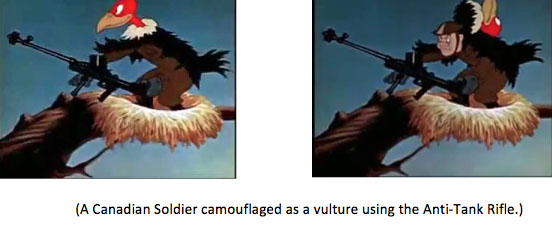
The film, created in cooperation with The Department of National Defence [sic] and The National Film Board of Canada, opens with a series of title cards that explain, “The Anti-Tank Rifle (Boys MK-1) is small and highly portable. It can easily be camouflaged and concealed on almost any type of terrain. When used as a weapon of surprise, it is highly effective against armoured [sic] fighting vehicles.” The last title card dissolves off and the there is a fade up from black and the cartoon portion of the film begins with several enemy tanks chugging along until they stop. The scene cuts to a close up of the top of one tank as the hatch opens and up pops a cartoon Adolf Hitler who extends his hand and says, “Heil.” The scene cuts to his point of view of five tanks and Nazi soldiers pop up out of their hatches and respond, “Heil Hitler.” The comical Hitler character mocks his opponents in German by claiming, “We are being oppressed…They can’t do this to me!” He points to a village and exclaims, “The enemy is asleep, We’ll give ‘em the works.” After an exaggerated burp he says, “GESUNDHEIT!” Dropping back into his tank, all the tanks start speeding towards the village firing shells.
The remainder of the short shows Canadian soldiers firing their MK-1 Anti-Tank rifle from various locations including a latrine. The tanks turn and speed off in defeat as Hitler’s tank goes off a cliff crashing on the ground below. A Canadian shell destroys the tank sending Hitler literally down to hell where he encounters an oversized Devil voiced by Billy Bletcher. Hitler proceeds to have a tantrum, ranting in German, as he undresses eventually laying down in front of the Devil who is initially amused. The devil looks at camera to translate and says, “Adolf says it isn’t fair… he’s being oppressed…he says it’s an outrage…” The Devil tries to speak but is interrupted by Hitler’s continuing tantrum and finally yells “quiet” as he hits Hitler with a cartoon mallet.
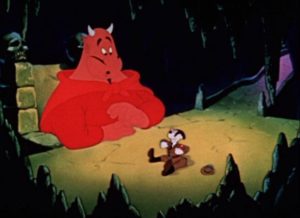 The Devil then looks at camera and translates Hitler’s rant, “Der Fuehrer says against your anti-tank rifles he simply can’t win.” The animation dissolves to black and then the fades up on a card that reads, “The Anti-Tank Rifle (Boys MK.1) Characteristics and Details of Operation.”
The Devil then looks at camera and translates Hitler’s rant, “Der Fuehrer says against your anti-tank rifles he simply can’t win.” The animation dissolves to black and then the fades up on a card that reads, “The Anti-Tank Rifle (Boys MK.1) Characteristics and Details of Operation.”
The film then goes into the live action and limited animation instructional portion that details the use and operation of the rifle. This section is exactly what you would expect in a training film about a rifle, dry and straight forward. Intermittently throughout the live action are cutaway scenes of comic relief and limited animation showing in more detail the various aspects of the rifles use. This limited animation is very effective in showing the inner workings of loading, firing and the cleaning of the weapon. Showing how a bullet fired from the rifle will penetrate the armor plating on a tank and at the most optimal angles would have been impossible to show any other way. The Canadian military said at the time, “…that a soldier can learn more from one showing of the picture, which runs about twenty minutes, than from a dozen lectures and demonstrations.” (Popular Science, October 1942, pg.63)
“Take good care of your rifle and keep it in first class condition. There is an old army saying, “your rifle is like a woman, if you treat her right, she will never let you down.” The scene cuts to full animation of a Canadian soldier in bed with his arm around his MK-1 rifle and as he kisses it, the narrator says, “Say, now that is going a little too far.” The soldier pulls the bed sheet up on his rifle and then with a put-off expression, pulls down the window shade and now in silhouette begins to kiss his rifle again as the scene fades to black. The film was released to military audiences in the spring of 1942.
The cartoon sequences are done in full character animation similar to the production value of the entertainment shorts being produced at the studio during that time. It showcases the appealing animation that Kimball and Moore are known for and is complemented by the graphic and convincing effects animation done by McManus. All of which is enhanced by a music score that quotes familiar and public domain themes including ‘Who’s Afraid of the Big Bad Wolf?’ from the Three Little Pigs (1933).
The combined public service messages of the Canadian war savings certificate films and the educational and instructional nature of Stop That Tank! extended the boundaries of cartoon animation beyond mere entertainment and opened up a new market for the Disney Studios. After the April 1941 conference at Disney showcased the studios animation acumen and the first of the war savings certificate films released in November 1941, the “Canadian government was the first to recognize and apply to national interests the talents of Walt Disney and his artists, the United States government was not far behind in tapping these resources.” (Donald Duck Joins Up; R. Shale, pg. 43). On December 8, 1941, Disney received its first United States Military contract from the Navy for a series of twenty films on aircraft and warship identification. But, it was the U.S. Treasury Departments request for a film encouraging Americans to pay their taxes that got the most notoriety.
You can read more about that in my article, Paying Income Taxes: The Disney Way.


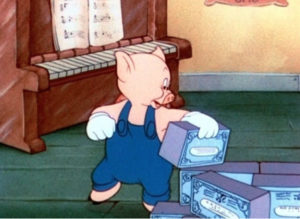
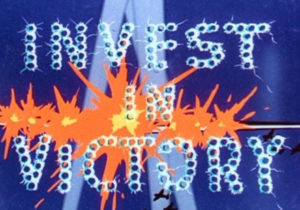
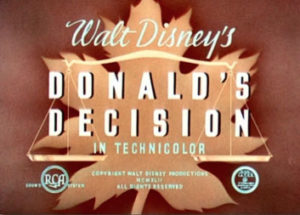
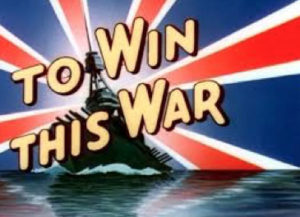
 David A. Bossert is an award-winning artist, filmmaker, and author. He received his B.A. from CalArts School of Film and Video with a major in Character Animation. As a 32-year veteran of The Walt Disney Company, he contributed his talents to The Black Cauldron (1985), Who Framed Roger Rabbit (1988), The Little Mermaid (1989), Beauty and the Beast (1991), Aladdin (1992), Tim Burton’s The Nightmare Before Christmas (1993), The Lion King (1995), Fantasia/2000 (1999), and the Academy Award-nominated shorts Runaway Brain (1995), Dali/Disney Destino (2003), and Lorenzo (2004), among many others. Bossert is now an independent producer, creative director, and writer.
David A. Bossert is an award-winning artist, filmmaker, and author. He received his B.A. from CalArts School of Film and Video with a major in Character Animation. As a 32-year veteran of The Walt Disney Company, he contributed his talents to The Black Cauldron (1985), Who Framed Roger Rabbit (1988), The Little Mermaid (1989), Beauty and the Beast (1991), Aladdin (1992), Tim Burton’s The Nightmare Before Christmas (1993), The Lion King (1995), Fantasia/2000 (1999), and the Academy Award-nominated shorts Runaway Brain (1995), Dali/Disney Destino (2003), and Lorenzo (2004), among many others. Bossert is now an independent producer, creative director, and writer.













































































“Department of National Defence” is the correct Canadian spelling. Spellings of words like “defense” denote use as a verb and “defence” use as a noun. License/licence and practise/practice are similar in British/Canadian use.
Forgot to mention that I enjoyed your article immensely. It answered some questions I’ve always had about how these cartoons came to be. Thanks for writing it.
I used the American spelling of “defense” instead of the Canadian version “defence” as you pointed out. I have made a note of that as spellcheck wants it to be with the “s”. I wish the software was smart enough to distinguish between the version based on whether the word Canadian/Canada/British appeared in the text. Wishful thinking.
I will be more conscious of this in the future especially with these WWII related films that were either made for or shown to the Allies. I appreciate you reading the piece and glad to hear that you enjoyed it. Thank you.
I remember first seeing these shorts on the ‘On the Front Lines’ Treasures DVD set and being fascinated at the blending of preexisting and new animation. ‘7 Wise Dwarfs’ in particular intrigued me with it’s use of the overture from the feature on the title cards and later the use of the soundtrack from the ‘Haunted Forest’ sequence during the ending montage. The way the music crescendos seemed to fit the exhortation to ‘BUY MORE BONDS!’ surprisingly well.
Looking at ‘All Together’, I believe that short reuses animation from another Disney promotional film, ‘Disney’s Standard Parade of 1939’, where the signs the characters hold originally plugged Standard Oil advertising gimmicks.
I produced the ON THE FRONT LINES DVD set for Disney Home Entertainment back in 2003/4. I was initially told that those films would never see the light of day. I was very happy not to believe that! Most of the Disney WWII era films reused existing animation whenever they could. It kept cost down and on some projects it was the only way to get it completed for the meager budget. Character animation and effects animation were reused sometimes by repainting the animation with a different color palette. They did this with the reuse of the SORCERERS APPRENTICE whirlpool which can be seen in the fighting montage at the end of THE NEW SPIRIT and THE SPIRIT OF ’43. There are countless examples of the clever reuse employed in all of these films.
Dave,
Thanks for sending this along. It’s always good to see articles about previously uncovered subjects.
[…] Disney and The National Film Board of Canada: Five for Four – Cartoon Research […]